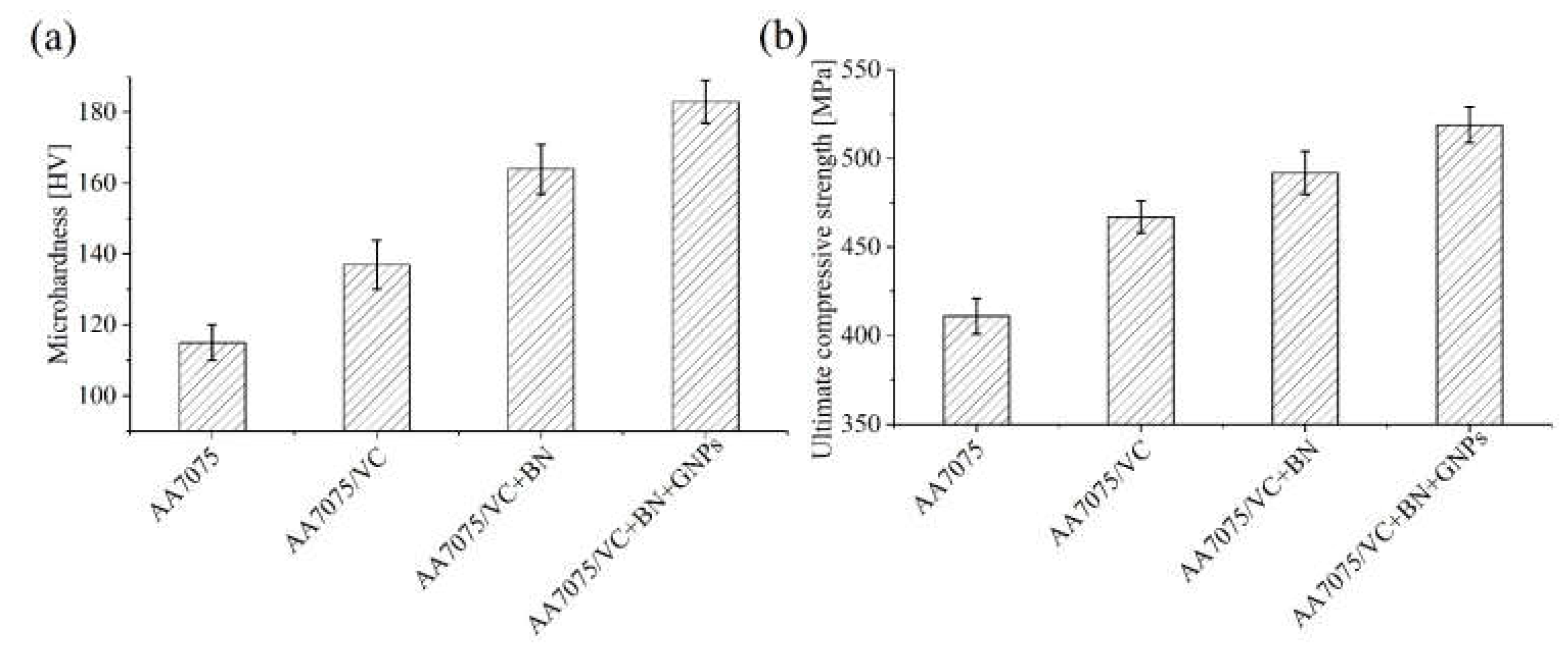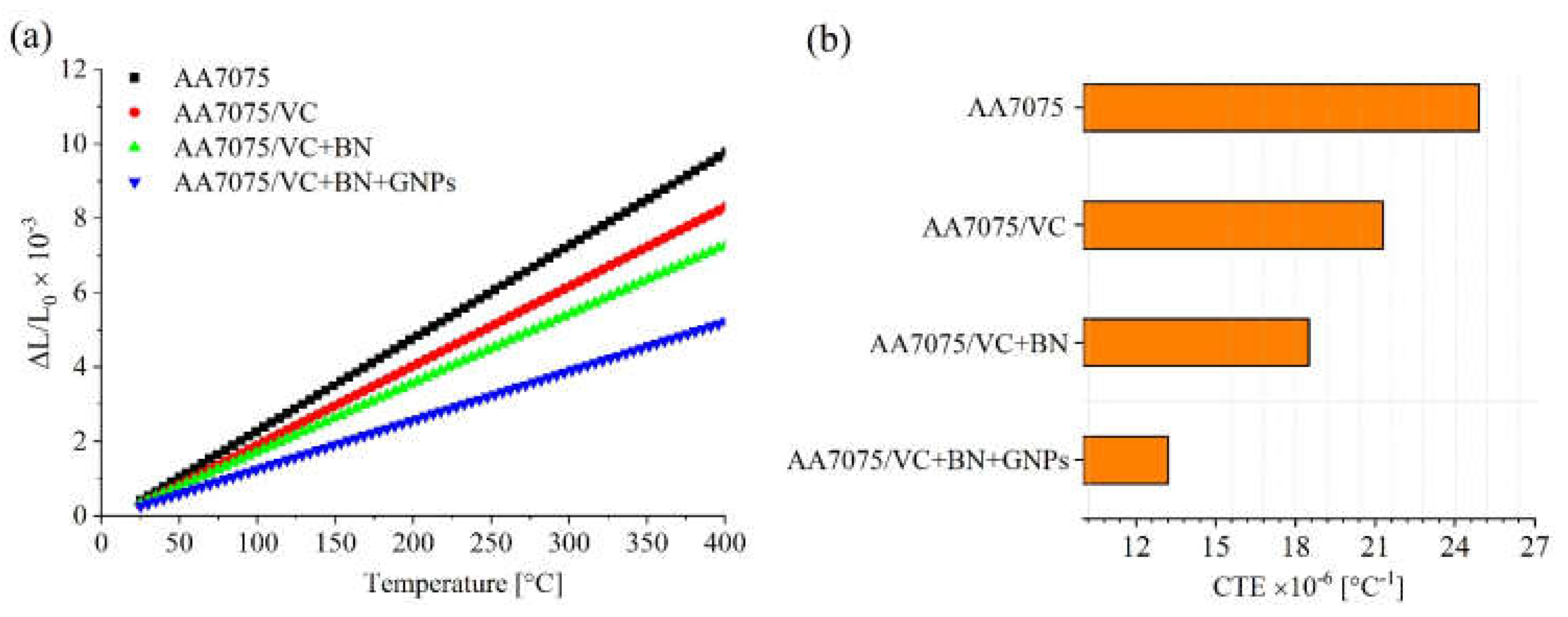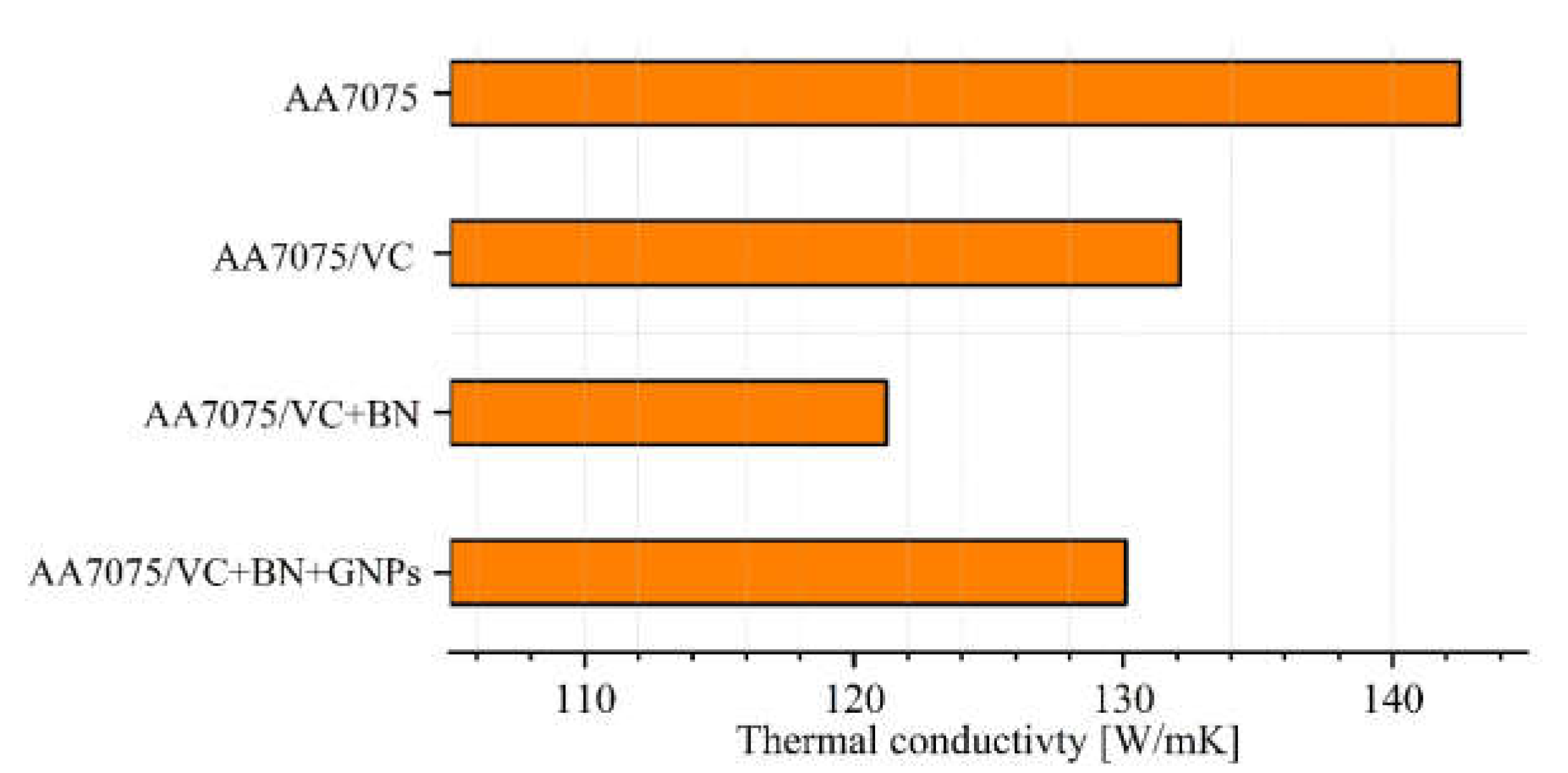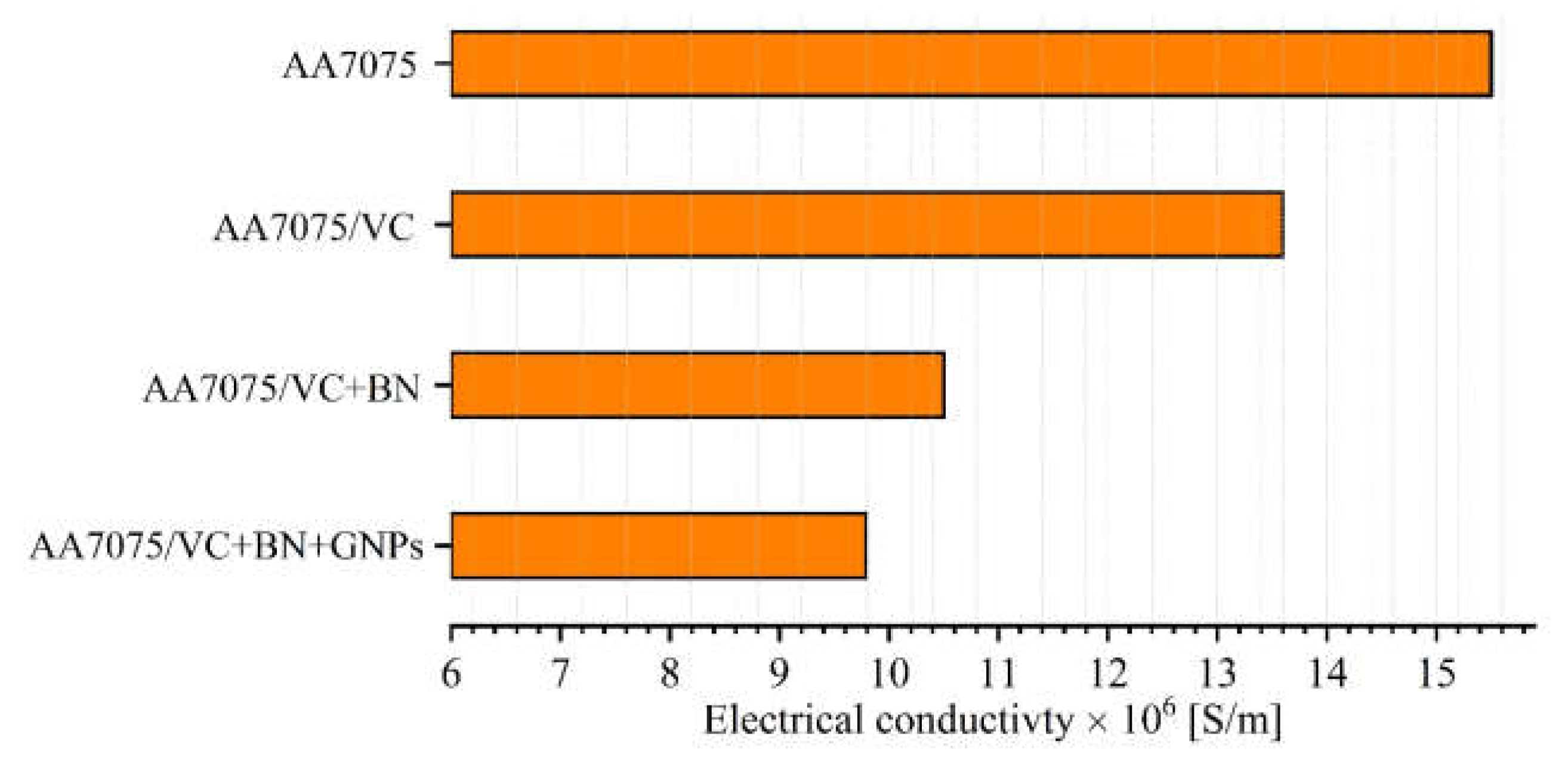Impact of Hard and Soft Reinforcements on the Microstructure, Mechanical, and Physical Properties of the Surface Composite Matrix Manufactured by Friction Stir Processing
Abstract
1. Introduction
2. Materials and Experiments
3. Results and Discussion
3.1. Microstructure Analysis
3.2. Mechanical Properties Analysis
3.3. Physical Characterizations
3.3.1. Thermal Analysis
3.3.2. Electrical Conductivity
4. Conclusions
- Significant grain refining was achieved in the stirred zone for all composites. The composite containing the GNPs exhibited the best refinement action compared to other reinforcements. The GNPs morphology (large surface area) helped restrict grain growth after the recrystallization during the FSP processing.
- The hardness and the ultimate compressive strength were improved significantly in the processed zone for all manufactured composites. The main reasons for this improvement were the presence of the reinforcements (dispersion strengthening) and the refining of grains (activated the grain boundary strengthening). The best improvement was recorded for the composite with GNPs. The large surface area of the GNPs could increase the adhesion between the matrix and the GNPs.
- The thermal expansion, thermal conductivity, and electrical conductivity were decreased in the manufactured composites, which was attributed to the reinforcements’ nature. The produced composites demonstrated thermal stability in their dimensions at the studied temperature range. The lowest thermal conductivity was observed in the composite reinforced with VC and BN.
Author Contributions
Funding
Institutional Review Board Statement
Informed Consent Statement
Data Availability Statement
Acknowledgments
Conflicts of Interest
References
- Joost, W.J. Reducing Vehicle Weight and Improving U.S. Energy Efficiency Using Integrated Computational Materials Engineering. JOM 2012, 64, 1032–1038. [Google Scholar] [CrossRef]
- Del Pero, F.; Delogu, M.; Pierini, M. The effect of lightweighting in automotive LCA perspective: Estimation of mass-induced fuel consumption reduction for gasoline turbocharged vehicles. J. Clean. Prod. 2017, 154, 566–577. [Google Scholar] [CrossRef]
- Mishra, R.; Ma, Z.; Charit, I. Friction stir processing: A novel technique for fabrication of surface composite. Mater. Sci. Eng. A 2003, 341, 307–310. [Google Scholar] [CrossRef]
- Jalilvand, M.M.; Mazaheri, Y. Effect of mono and hybrid ceramic reinforcement particles on the tribological behavior of the AZ31 matrix surface composites developed by friction stir processing. Ceram. Int. 2020, 46, 20345–20356. [Google Scholar] [CrossRef]
- García-Vázquez, F.; Vargas-Arista, B.; Muñiz, R.; Ortiz, J.C.; García, H.H.; Acevedo, J. The Role of Friction Stir Processing (FSP) Parameters on TiC Reinforced Surface Al7075-T651 Aluminum Alloy. Soldag. Inspeção 2016, 21, 508–516. [Google Scholar] [CrossRef]
- Moustafa, E.B.; Melaibari, A.; Alsoruji, G.; Khalil, A.M.; Mosleh, A.O. Tribological and mechanical characteristics of AA5083 alloy reinforced by hybridising heavy ceramic particles Ta2C & VC with light GNP and Al2O3 nanoparticles. Ceram. Int. 2022, 48, 4710–4721. [Google Scholar] [CrossRef]
- Jain, V.K.; Yadav, M.K.; Siddiquee, A.N.; Khan, Z.A. Fabrication of surface composites on different aluminium alloys via friction stir process-A review report. Aust. J. Mech. Eng. 2022, 1–24. [Google Scholar] [CrossRef]
- Imran, M.; Khan, A.R.A. Characterization of Al-7075 metal matrix composites: A review. J. Mater. Res. Technol. 2019, 8, 3347–3356. [Google Scholar] [CrossRef]
- Sambathkumar, M.; Navaneethakrishnan, P.; Ponappa, K.; Sasikumar, K.S.K. Mechanical and Corrosion Behavior of Al7075 (Hybrid) Metal Matrix Composites by Two Step Stir Casting Process. Lat. Am. J. Solids Struct. 2017, 14, 243–255. [Google Scholar] [CrossRef]
- Arun Kumar, S.; Hari Vignesh, J.; Paul Joshua, S. Investigating the effect of porosity on aluminium 7075 alloy reinforced with silicon nitride (Si3N4) metal matrix composites through STIR casting process. Mater. Today Proc. 2021, 39, 414–419. [Google Scholar] [CrossRef]
- Kumar, G.V.; Rao, C.S.P.; Selvaraj, N.; Bhagyashekar, M.S. Studies on Al6061-SiC and Al7075-Al 2 O 3 metal matrix composites. J. Min. Mater. Charact. Eng. 2010, 9, 43. [Google Scholar]
- Doel, T.J.A.; Bowen, P. Tensile properties of particulate-reinforced metal matrix composites. Compos. Part A Appl. Sci. Manuf. 1996, 27, 655–665. [Google Scholar] [CrossRef]
- Baradeswaran, A.; Elaya Perumal, A. Influence of B4C on the tribological and mechanical properties of Al 7075–B4C composites. Compos. Part B Eng. 2013, 54, 146–152. [Google Scholar] [CrossRef]
- Sahu, M.K.; Sahu, R.K. Synthesis, microstructure and hardness of Al 7075/B4C/Fly-ash composite using stir casting method. Mater. Today Proc. 2020, 27, 2401–2406. [Google Scholar] [CrossRef]
- Suresh, S.; Gowd, G.H.; Deva Kumar, M.L.S. Tribological Behavior of Al 7075/SiC Metal Matrix Nano-composite by Stir Casting Method. J. Inst. Eng. Ser. D 2019, 100, 97–103. [Google Scholar] [CrossRef]
- Saboori, A.; Moheimani, S.; Dadkhah, M.; Pavese, M.; Badini, C.; Fino, P. An Overview of Key Challenges in the Fabrication of Metal Matrix Nanocomposites Reinforced by Graphene Nanoplatelets. Metals 2018, 8, 172. [Google Scholar] [CrossRef]
- Moustafa, E.B.; Melaibari, A.; Basha, M. Wear and microhardness behaviors of AA7075/SiC-BN hybrid nanocomposite surfaces fabricated by friction stir processing. Ceram. Int. 2020, 46, 16938–16943. [Google Scholar] [CrossRef]
- Mehta, K.M.; Badheka, V.J. Wear behavior of boron-carbide reinforced aluminum surface composites fabricated by Friction Stir Processing. Wear 2019, 426, 975–980. [Google Scholar] [CrossRef]
- Khoshaim, A.B.; Moustafa, E.B.; Alazwari, M.A.; Taha, M.A. An Investigation of the Mechanical, Thermal and Electrical Properties of an AA7075 Alloy Reinforced with Hybrid Ceramic Nanoparticles Using Friction Stir Processing. Metals 2023, 13, 124. [Google Scholar] [CrossRef]
- Moustafa, E.B.; Mikhaylovskaya, A.V.; Taha, M.A.; Mosleh, A.O. Improvement of the microstructure and mechanical properties by hybridizing the surface of AA7075 by hexagonal boron nitride with carbide particles using the FSP process. J. Mater. Res. Technol. 2022, 17, 1986–1999. [Google Scholar] [CrossRef]
- Abushanab, W.S.; Moustafa, E.B.; Melaibari, A.A.; Kotov, A.D.; Mosleh, A.O. A Novel Comparative Study Based on the Economic Feasibility of the Ceramic Nanoparticles Role’s in Improving the Properties of the AA5250 Nanocomposites. Coatings 2021, 11, 977. [Google Scholar] [CrossRef]
- Patel, S.K.; Singh, V.P.; Roy, B.S.; Kuriachen, B. Recent research progresses in Al-7075 based in-situ surface composite fabrication through friction stir processing: A review. Mater. Sci. Eng. B 2020, 262, 114708. [Google Scholar] [CrossRef]
- ASTM E3-11; Standard Guide for Preparation of Metallographic Specimens 1. ASTM Copyright: West Conshohocken, PA, USA, 2011; Volume i, pp. 1–12. [CrossRef]
- ASTM E112-10; Standard Test Methods for Determining Average Grain Size E112-10. ASTM: West Conshohocken, PA, USA, 2010; Volume 96, pp. 1–27. [CrossRef]
- Moustafa, E.B.; Taha, M.A. Preparation of high strength graphene reinforced Cu-based nanocomposites via mechanical alloying method: Microstructural, mechanical and electrical properties. Appl. Phys. A 2020, 126, 220. [Google Scholar] [CrossRef]
- Moustafa, E.B.; Elsheikh, A.H.; Taha, M.A. The effect of TaC and NbC hybrid and mono-nanoparticles on AA2024 nanocomposites: Microstructure, strengthening, and artificial aging. Nanotechnol. Rev. 2022, 11, 2513–2525. [Google Scholar] [CrossRef]
- Alsoruji, G.; Moustafa, E.B.; Alzahrani, M.A.; Taha, M.A. Preparation of Silicon Bronze-Based Hybrid Nanocomposites with Excellent Mechanical, Electrical, and Wear Properties by Adding the Ti3AlC2 MAX Phase and Granite Via Powder Metallurgy. Silicon 2022. [Google Scholar] [CrossRef]
- Ramadan, S.; Taha, M.A.; El-Meligy, W.M.; Saudi, H.A.; Zawrah, M.F. Influence of Graphene Content on Sinterability and Physico-Mechanical Characteristics of Al/Graphene Composites Prepared via Powder Metallurgy. Biointerface Res. Appl. Chem. 2022, 13, 192. [Google Scholar] [CrossRef]
- Hossein-Zadeh, M.; Razavi, M.; Mirzaee, O.; Ghaderi, R. Characterization of properties of Al–Al2O3 nano-composite synthesized via milling and subsequent casting. J. King Saud. Univ. Eng. Sci. 2013, 25, 75–80. [Google Scholar] [CrossRef]
- Moustafa, E.B.; Alazwari, M.A.; Abushanab, W.S.; Ghandourah, E.I.; Mosleh, A.O.; Ahmed, H.M.; Taha, M.A. Influence of Friction Stir Process on the Physical, Microstructural, Corrosive, and Electrical Properties of an Al–Mg Alloy Modified with Ti–B Additives. Materials 2022, 15, 835. [Google Scholar] [CrossRef]
- AbuShanab, W.S.; Moustafa, E.B.; Ghandourah, E.; Taha, M.A. Effect of graphene nanoparticles on the physical and mechanical properties of the Al2024-graphene nanocomposites fabricated by powder metallurgy. Results Phys. 2020, 19, 103343. [Google Scholar] [CrossRef]
- Hwang, J.; Tak, W.-S.; Mun, S.Y.; Nam, S.; Moon, S.Y.; Kim, W.S. Graphene Encapsulated Al Particles for Improvement of Thermal Conductivity in Composites. Materials 2020, 13, 3602. [Google Scholar] [CrossRef]
- Pradhan, S.K.; Sahoo, M.R.; Ratha, S.; Polai, B.; Mitra, A.; Sathpathy, B.; Sahu, A.; Kar, S.; Satyam, P.V.; Ajayan, P.M.; et al. Graphene-incorporated aluminum with enhanced thermal and mechanical properties for solar heat collectors. AIP Adv. 2020, 10, 065016. [Google Scholar] [CrossRef]
- Sang, M.; Shin, J.; Kim, K.; Yu, K. Electronic and Thermal Properties of Graphene and Recent Advances in Graphene Based Electronics Applications. Nanomaterials 2019, 9, 374. [Google Scholar] [CrossRef] [PubMed]
- AbuShanab, W.S.; Moustafa, E.B.; Ghandourah, E.; Taha, M.A. The Effect of Different Fly Ash and Vanadium Carbide Contents on the Various Properties of Hypereutectic Al-Si Alloys-Based Hybrid Nanocomposites. Silicon 2022, 14, 5367–5377. [Google Scholar] [CrossRef]
- Zhou, W.; Qi, S.; An, Q.; Zhao, H.; Liu, N. Thermal conductivity of boron nitride reinforced polyethylene composites. Mater. Res. Bull. 2007, 42, 1863–1873. [Google Scholar] [CrossRef]








| Zn | Mg | Cu | Cr | Fe | Si | Mn | Balance |
|---|---|---|---|---|---|---|---|
| 5.7 | 2.3 | 1.4 | 0.18 | 0.35 | 0.2 | 0.2 | Al |
| Reinforcement | Dimensions | Purity (%) * | Density (g/cm3) |
|---|---|---|---|
| VC | Diameter = 300:550 nm | >99 | 5.77 |
| BN | Diameter = 100 ± 10 nm | 99 | 2.1 |
| GNPs | Thickness = 7 ± 0.6 nm Wide = 5 ± 0.5 μm | >99 | 2.2 |
| Property/Composite | AA7075/VC | AA7075/VC + BN | AA7075/VC + BN+GNPs |
|---|---|---|---|
| Grain refining (decreased) | 720 | 740 | 930 |
| Microhardness (increased) | 20 | 43 | 60 |
| Ultimate compressive strength (increased) | 14 | 21 | 29 |
| CTE (decreased) | 17 | 35 | 88 |
| Thermal conductivity (decreased) | 6.7 | 15 | 8.9 |
| Electrical conductivity (decreased) | 14 | 48 | 58 |
Disclaimer/Publisher’s Note: The statements, opinions and data contained in all publications are solely those of the individual author(s) and contributor(s) and not of MDPI and/or the editor(s). MDPI and/or the editor(s) disclaim responsibility for any injury to people or property resulting from any ideas, methods, instructions or products referred to in the content. |
© 2023 by the authors. Licensee MDPI, Basel, Switzerland. This article is an open access article distributed under the terms and conditions of the Creative Commons Attribution (CC BY) license (https://creativecommons.org/licenses/by/4.0/).
Share and Cite
Abushanab, W.S.; Moustafa, E.B.; Ghandourah, E.I.; Hussein, H.; Taha, M.A.; Mosleh, A.O. Impact of Hard and Soft Reinforcements on the Microstructure, Mechanical, and Physical Properties of the Surface Composite Matrix Manufactured by Friction Stir Processing. Coatings 2023, 13, 284. https://doi.org/10.3390/coatings13020284
Abushanab WS, Moustafa EB, Ghandourah EI, Hussein H, Taha MA, Mosleh AO. Impact of Hard and Soft Reinforcements on the Microstructure, Mechanical, and Physical Properties of the Surface Composite Matrix Manufactured by Friction Stir Processing. Coatings. 2023; 13(2):284. https://doi.org/10.3390/coatings13020284
Chicago/Turabian StyleAbushanab, Waheed Sami, Essam B. Moustafa, Emad Ismat Ghandourah, Hossameldin Hussein, Mohammed A. Taha, and Ahmed O. Mosleh. 2023. "Impact of Hard and Soft Reinforcements on the Microstructure, Mechanical, and Physical Properties of the Surface Composite Matrix Manufactured by Friction Stir Processing" Coatings 13, no. 2: 284. https://doi.org/10.3390/coatings13020284
APA StyleAbushanab, W. S., Moustafa, E. B., Ghandourah, E. I., Hussein, H., Taha, M. A., & Mosleh, A. O. (2023). Impact of Hard and Soft Reinforcements on the Microstructure, Mechanical, and Physical Properties of the Surface Composite Matrix Manufactured by Friction Stir Processing. Coatings, 13(2), 284. https://doi.org/10.3390/coatings13020284


.jpg)







